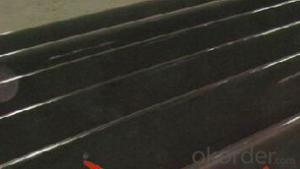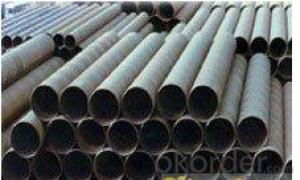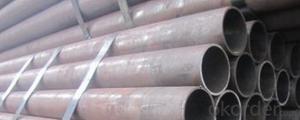Schedule 40 Seamless Carbon Steel Pipe A335 J55 CNBM
- Loading Port:
- Qingdao
- Payment Terms:
- TT OR LC
- Min Order Qty:
- 10 pc
- Supply Capability:
- 30 pc/month
OKorder Service Pledge
OKorder Financial Service
You Might Also Like
Quick Details
| Thickness: | 1.73 - 59.54 mm | Section Shape: | Round | Outer Diameter: | 10.3 - 914.4 mm |
| Secondary Or Not: | Non-secondary | Application: | Fluid Pipe | ||
| Technique: | Hot Rolled | Certification: | API | Surface Treatment: | Galvanized,vanish covering, black painting, galvenized ect. |
| Special Pipe: | API Pipe | Alloy Or Not: | Non-alloy | Length: | 5-12m as per customer's requirements |
| SCH: | SCH10~160, STD, XS & XXS | Payment Terms: | L/C T/T | Supply Ability: | 5000 Ton/Tons per Week |
| Product: | pipe prices | Grade: | 10#,20#,45#,A106(B,C),A53(A,B),12Cr1MoV,12Cr1MoVG,12Cr2Mo,13CrMo44,13CrMo45,15CrMo,15CrMoG,St52,St52.4,10#-45#,A53-A369,Cr-Mo alloy,ST35-ST52 | Standard: | API 5CT,API 5L,ASTM A106-2006,ASTM A53-2007,DIN 17175,GB 3087-1999,GB 5130,GB 6479-2000,GB 9948-2006,GB/T 17396-1998,GB/T 5312-1999,GB/T 8162-1999,GB/T 8163-1999,API,ASTM,DIN,GB |
Packaging & Delivery
| Packaging Detail: | By bundles, seaworthy wooden cases, steel framed cases, and simple packaging or according to the demand of the customers. |
| Delivery Detail: | within 5-15 days |
Specifications
1.pipe prices
2.Supply Ability:5000 Tons per Week
3.Payment Terms:L/C T/T
High quality Carbon steel pipe, Best pipe prices
1) Application: Overheat pipe for low and mediumpressure boiler,boiling water pipe, locomotive smoke pipe(big and small),Carry gas ,water or oil in the industries of petroleum and natural gas etc
2) Materials: 10#, 20#, 45#, 15CrMo, 12Cr1MoV, 13CrMo44, 12Cr2Mo, 13CrMo45, 12Cr1MoVG, 15CrMoG, API J55, API K55, API N80, API L80, API P110
3)Pipe according to standard: GB 3087-1999, GB/T 8163-1999, GB/T 8162-1999, GB 9948-2006, GB/T 17396-1998, GB/T 5312-1999, GB 6479-2000, GB 5130, DIN 17175, API 5CT, API 5L .
4)Packing: By bundles, seaworthy wooden cases, steel framed cases, and simple packaging or according to the demand of the customers.
Technical Parameters of Seamless Steel Pipe
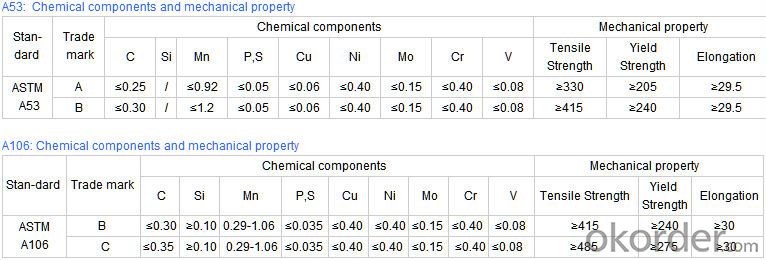
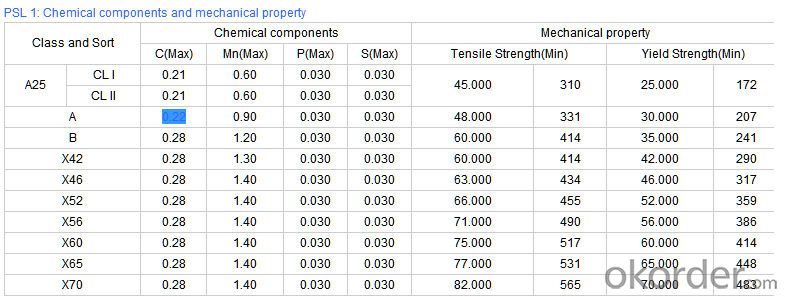
- Q:Can steel pipes be used for heat exchangers?
- Yes, steel pipes can be used for heat exchangers. Steel is a commonly used material for heat exchangers due to its high thermal conductivity and durability. It can efficiently transfer heat between two fluids, making it suitable for various industrial applications.
- Q:How do you determine the maximum allowable stress for steel pipes?
- In order to establish the maximum allowable stress for steel pipes, several factors must be taken into account. These factors encompass the type of steel, the dimensions of the pipe, and the operating conditions it will be exposed to. To begin with, the type of steel chosen is a pivotal aspect in determining the maximum allowable stress. Different steel grades possess distinct mechanical properties, including yield strength, tensile strength, and elongation. These properties define the steel's capacity to withstand stress before deforming or failing. Hence, it is crucial to comprehend the specific grade of steel employed in the pipes to ascertain the maximum allowable stress. Additionally, the dimensions of the pipe are of utmost importance. The external diameter, wall thickness, and length all impact the pipe's strength and ability to handle stress. By calculating the cross-sectional area and moment of inertia, engineers can evaluate the pipe's resistance to bending and axial stresses. These calculations, combined with the material properties, facilitate the determination of the maximum allowable stress. Finally, the operating conditions under which the pipe will be utilized play a critical role. Variables such as temperature, pressure, and the presence of corrosive substances can significantly influence the maximum allowable stress of a steel pipe. Elevated temperatures can alter the mechanical properties of the steel, while high pressures can induce additional stress. Furthermore, the presence of corrosive substances can lead to material degradation and diminish the pipe's strength. Thus, considering these operational factors is essential when determining the maximum allowable stress. To summarize, the process of establishing the maximum allowable stress for steel pipes entails assessing the specific steel grade, the pipe's dimensions, and the operating conditions. By analyzing these factors, engineers can ensure that the steel pipe is designed and utilized within its safe stress limits.
- Q:What is the outer diameter and wall thickness of DN40 steel pipe?
- DN40 pipe diameter 48.3mm diameter, allowable deviation of plus or minus 0.5mm it depends on what you have, the outside diameter of 45, there are other dimensions, you can see the manual
- Q:How are steel pipes used in building foundations?
- Steel pipes are often used in building foundations as piles or piers. They are driven into the ground to provide structural support and stability for the building. The steel pipes act as load-bearing elements, transferring the weight of the structure to the underlying soil or rock. Additionally, they can also be utilized for underground utility installations or as part of a drainage system in building foundations.
- Q:How do you calculate the pipe friction loss coefficient for steel pipes?
- To calculate the pipe friction loss coefficient for steel pipes, you need to consider several factors. One of the most common methods used is the Darcy-Weisbach equation, which relates the frictional head loss in a pipe to the flow rate, pipe diameter, pipe length, fluid properties, and the pipe roughness coefficient. The Darcy-Weisbach equation is expressed as: hf = (f * L * V^2) / (2 * g * D) Where: hf is the head loss due to friction, f is the pipe friction factor, L is the pipe length, V is the fluid velocity, g is the acceleration due to gravity, and D is the pipe diameter. The pipe friction factor, f, is the key parameter that needs to be determined. For steel pipes, this factor depends on the pipe roughness coefficient, which represents the relative roughness of the pipe. The relative roughness is calculated by dividing the absolute roughness of the pipe surface by the pipe diameter. The pipe roughness coefficient can be obtained from various sources, such as manufacturer specifications, engineering handbooks, or experimental data. It is important to ensure that the roughness coefficient used matches the specific type and condition of the steel pipe being analyzed. Once you have the pipe roughness coefficient, you can use it to calculate the pipe friction factor using empirical correlations or charts. These correlations often involve Reynolds number, which is a dimensionless quantity that characterizes the flow regime. By substituting the obtained pipe friction factor into the Darcy-Weisbach equation, you can calculate the head loss due to friction for steel pipes. This value is essential in designing piping systems, determining pump requirements, or estimating energy consumption in fluid flow applications.
- Q:Are steel pipes suitable for structural applications?
- Yes, steel pipes are suitable for structural applications. Steel pipes are known for their strength, durability, and versatility, making them ideal for various structural applications. They can be used in buildings, bridges, stadiums, and other structures to provide support and stability. Steel pipes have high tensile strength, which allows them to withstand heavy loads and resist deformation under pressure. Additionally, their resistance to corrosion makes them a reliable choice for structural applications, even in harsh environments. The use of steel pipes in structural applications is further enhanced by their cost-effectiveness and easy installation. Overall, steel pipes are a popular choice in the construction industry due to their strength, durability, versatility, and cost-effectiveness.
- Q:What are the different surface finishes available for steel pipes?
- There are several different surface finishes available for steel pipes, including mill finish, hot-dip galvanized, black oxide, epoxy coating, and powder coating.
- Q:Can steel pipes be used for conveying abrasive slurries?
- Yes, steel pipes can be used for conveying abrasive slurries. Steel pipes are known for their durability and strength, making them suitable for handling abrasive materials such as slurries. However, to ensure longevity and prevent excessive wear, it is important to select the appropriate grade of steel and consider factors such as pipe thickness, lining options, and flow velocity. Additionally, implementing proper maintenance and inspection procedures can help to detect and address any wear or corrosion that may occur over time.
- Q:What is the maximum allowable deflection for steel pipes?
- Industry standards and design codes typically determine the maximum allowable deflection for steel pipes. These regulations specify the acceptable limits of deflection to guarantee the pipes' structural integrity and functionality. The maximum allowable deflection can vary, depending on factors like pipe diameter, wall thickness, material properties, and the application type. To determine the specific maximum allowable deflection for a particular steel pipe application, it is crucial to reference relevant standards and codes such as the ASME B31.3 code for process piping or AWWA standards for water transmission and distribution pipes. Adhering to these guidelines ensures the safe and efficient operation of steel pipes in various industries and applications.
- Q:How are steel pipes used in the manufacturing of agricultural machinery and equipment?
- Steel pipes are commonly used in the manufacturing of agricultural machinery and equipment due to their strength, durability, and versatility. These pipes are used for various purposes such as forming the structural framework, creating hydraulic systems, and providing conduits for fluid and air transportation. Whether it's for building tractor chassis, constructing irrigation systems, or manufacturing grain storage equipment, steel pipes play a crucial role in ensuring the reliability and efficiency of agricultural machinery.
1. Manufacturer Overview |
|
|---|---|
| Location | |
| Year Established | |
| Annual Output Value | |
| Main Markets | |
| Company Certifications | |
2. Manufacturer Certificates |
|
|---|---|
| a) Certification Name | |
| Range | |
| Reference | |
| Validity Period | |
3. Manufacturer Capability |
|
|---|---|
| a)Trade Capacity | |
| Nearest Port | |
| Export Percentage | |
| No.of Employees in Trade Department | |
| Language Spoken: | |
| b)Factory Information | |
| Factory Size: | |
| No. of Production Lines | |
| Contract Manufacturing | |
| Product Price Range | |
Send your message to us
Schedule 40 Seamless Carbon Steel Pipe A335 J55 CNBM
- Loading Port:
- Qingdao
- Payment Terms:
- TT OR LC
- Min Order Qty:
- 10 pc
- Supply Capability:
- 30 pc/month
OKorder Service Pledge
OKorder Financial Service
Similar products
New products
Hot products
Related keywords

